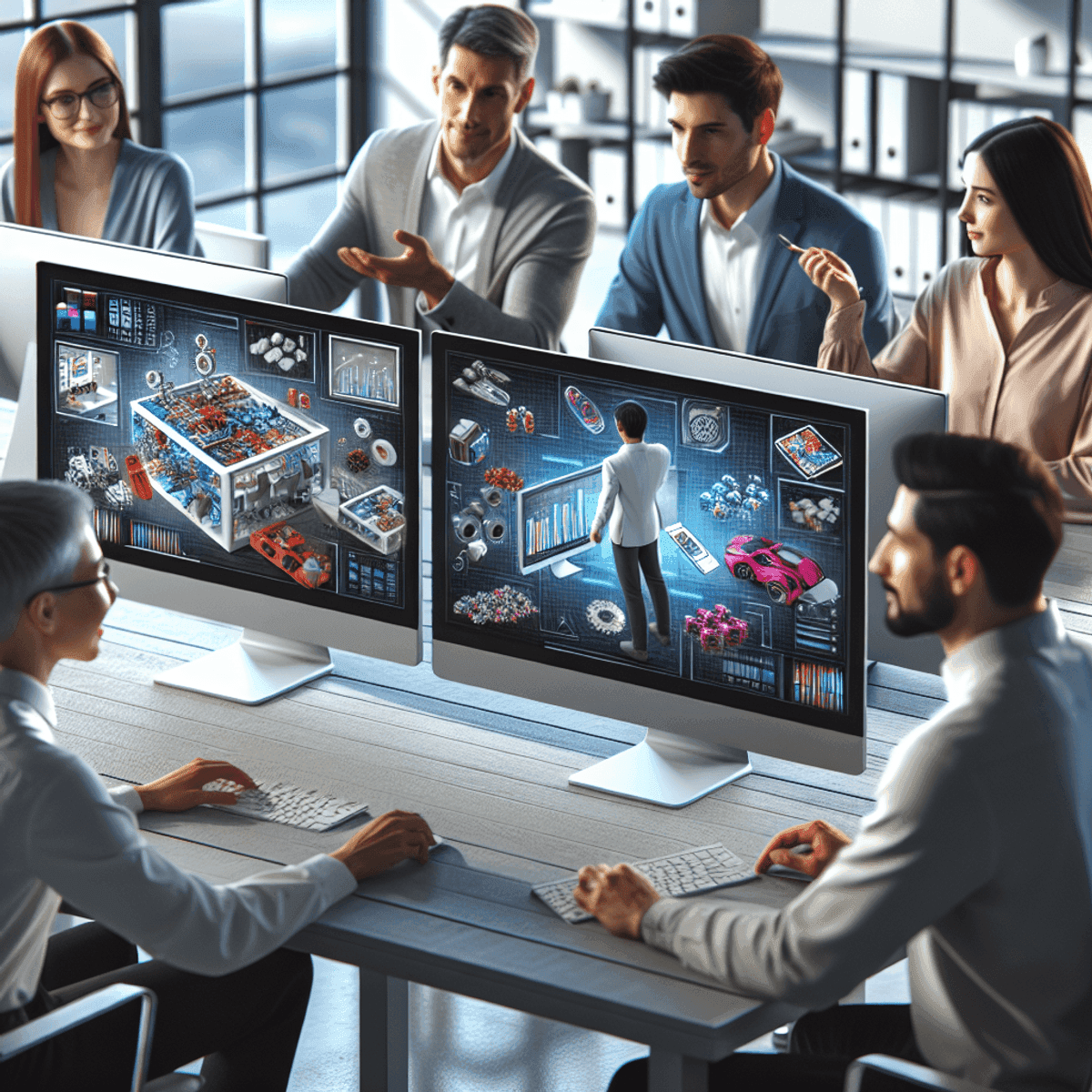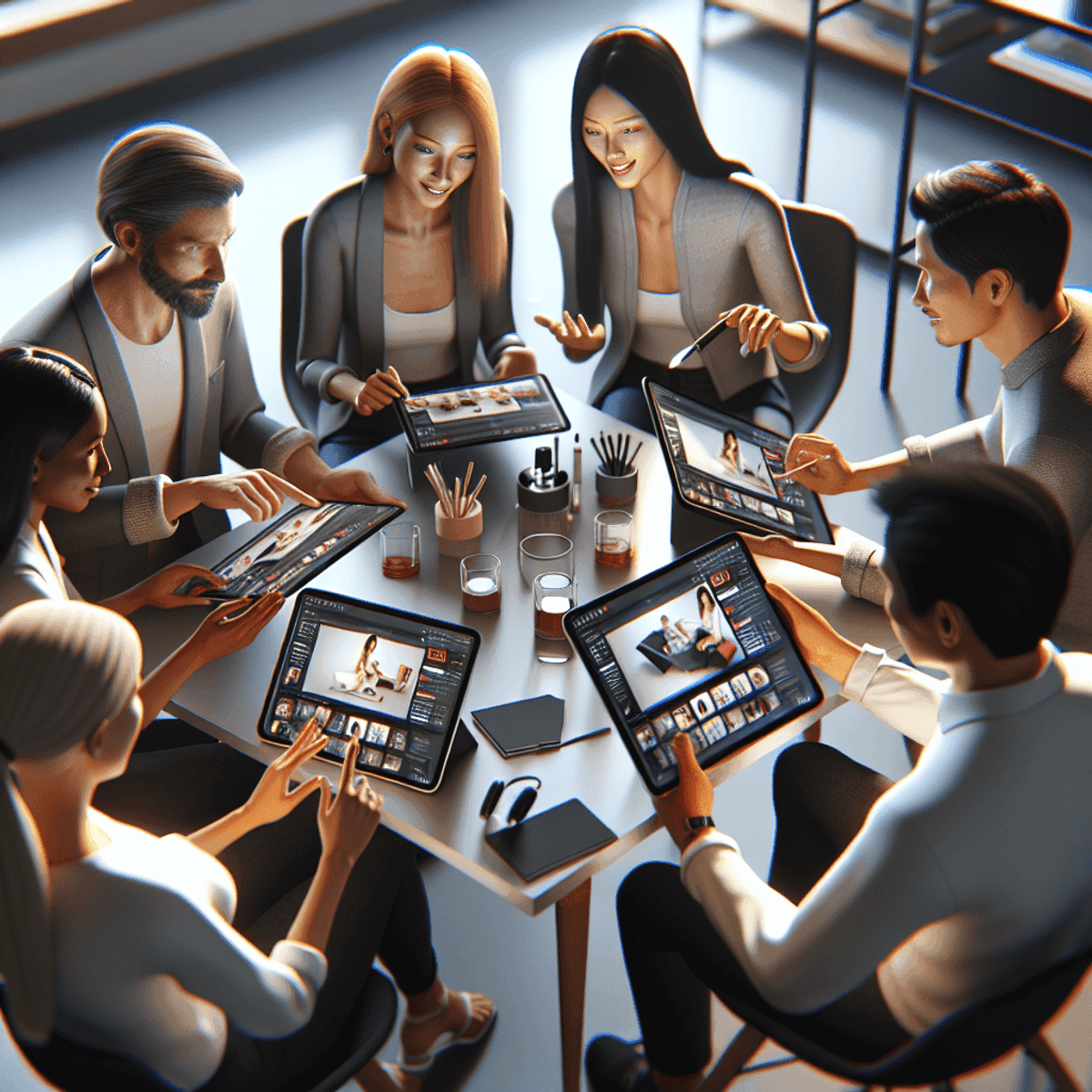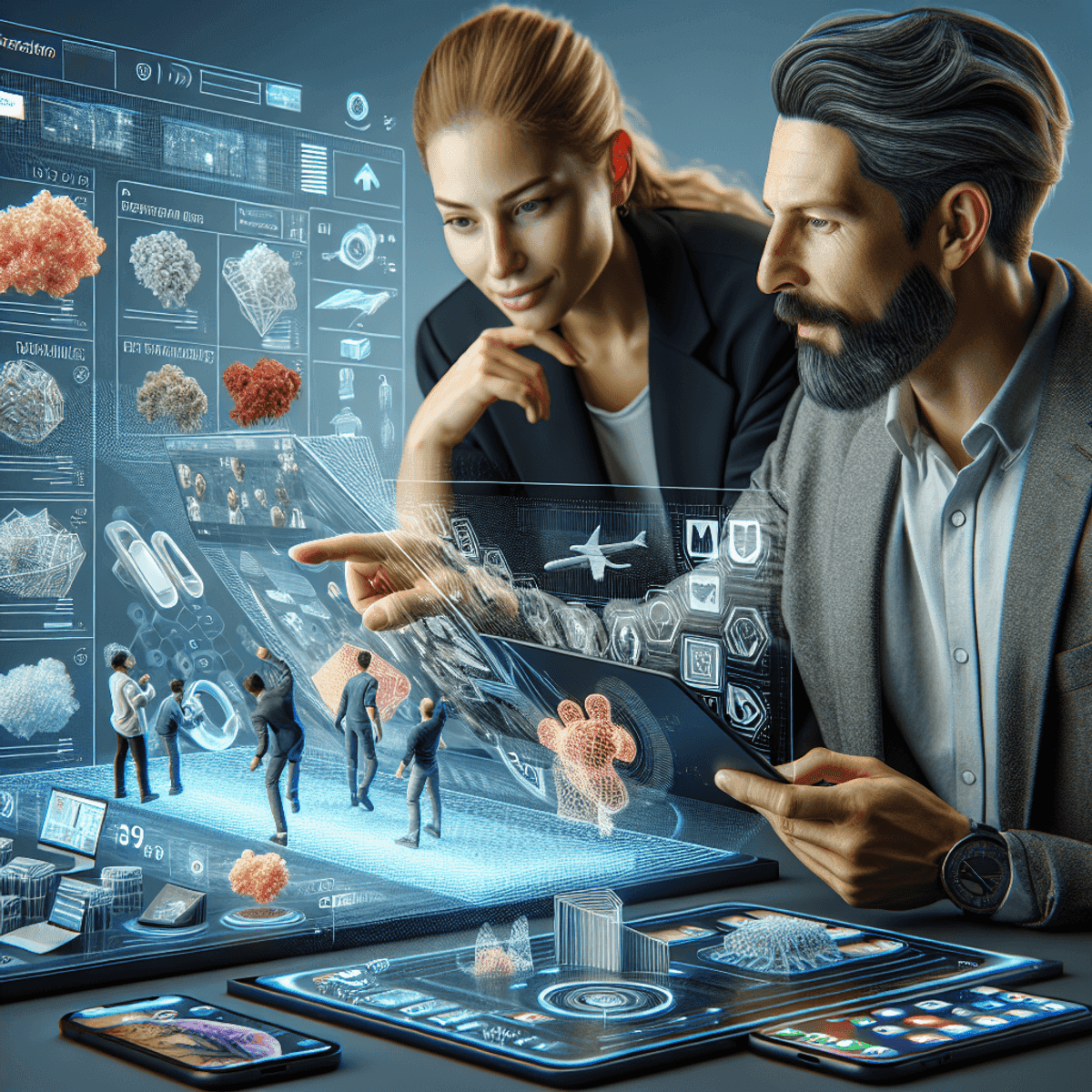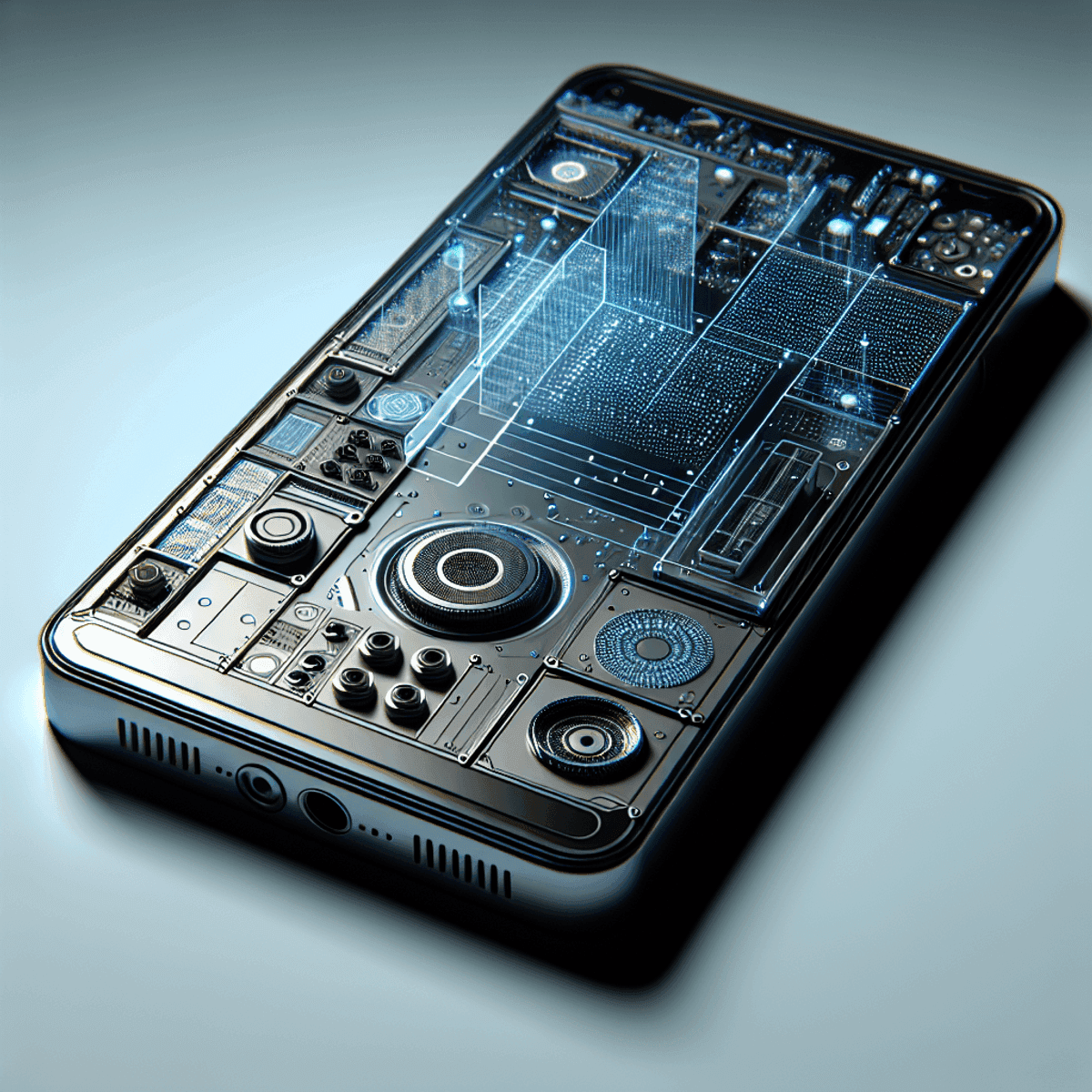Introduction
3D product rendering is a cutting-edge technology that brings products to life through hyper-realistic digital images. In the world of modern marketing, these renderings play a crucial role by offering detailed and visually appealing representations of products, which can be used across various platforms—websites, social media, and advertising campaigns.
Understanding the ROI of 3D Product Rendering is crucial for businesses considering this investment. ROI, or return on investment, measures the profitability relative to the costs involved. When it comes to 3D product rendering, evaluating ROI helps companies determine whether the benefits outweigh the expenses.
Key benefits and ROI factors discussed in this article include:
Improved customer engagement through immersive experiences
Competitive advantage via high-quality visuals
Reduction in return rates due to accurate product depictions
Cost-effectiveness for startups and established businesses alike
This comprehensive exploration will illustrate how investing in product rendering services can drive tangible outcomes for your business.
Understanding 3D Product Rendering
What is 3D Product Rendering?
3D product rendering is a digital process that creates photorealistic images of products using computer software. Unlike traditional photography, which relies on physical prototypes and real-world settings, 3D rendering leverages advanced algorithms to generate lifelike visuals. Core components of 3D product rendering include:
3D Modeling: The creation of a digital representation of the product.
Texturing: Applying materials and colors to the 3D model to enhance realism.
Lighting: Simulating light sources to replicate how they would interact with the product.
Rendering: The final step where the 3D scene is processed into a high-resolution image.
Differences Between Traditional and 3D Product Visualization
Visual Appeal
Traditional product photography captures real-world images, limited by physical constraints such as lighting conditions and camera quality. In contrast, 3D product rendering allows for photorealistic visuals, providing unmatched flexibility in adjusting angles, lighting, and textures. This capability ensures that every detail is meticulously represented, resulting in superior visual appeal.
Cost-Effectiveness
Traditional photography often requires extensive setups, including studio rentals, professional photographers, and multiple prototypes. These costs can escalate quickly, especially for complex products or frequent re-shoots. However, Product Rendering Services, like those offered by Jobe Graphic, eliminate many of these expenses by enabling virtual adjustments and eliminating the need for physical prototypes. This approach significantly reduces overall costs while maintaining high-quality outputs.
Scalability
Scaling up marketing efforts with traditional photography demands increased logistical efforts—more photoshoots, more prototypes, and more time. Conversely, 3D product rendering offers exceptional scalability. Once a digital model is created, it can be easily manipulated to produce various images from different angles or in different settings without additional costs or time-consuming processes.
Advantages of Photorealistic Visuals and 3D Modeling
Photorealistic rendering enhances product presentation by creating highly detailed and true-to-life images that capture the essence of the product. This accuracy plays a pivotal role in:
Customer Engagement: High-quality visuals attract attention and keep customers engaged longer.
Brand Perception: Professional-grade images elevate brand perception, positioning the company as innovative and quality-focused.
Providing Immersive Experiences for Online Shoppers
3D visualization transforms online shopping into an immersive experience by allowing customers to explore products in ways traditional photos can't match. Interactive elements such as:
360-Degree Views: Enables users to rotate the product for a comprehensive view.
Zoom Functions: Allow detailed examination of intricate features.
These tools offer an enhanced understanding of the product's features and benefits, leading to more informed purchasing decisions.
By understanding these distinctions and advantages, businesses can leverage 3D product rendering. Learn more by visiting our blog.
The Tangible Benefits of 3D Rendering
Customer Engagement through Immersive Experiences
3D product rendering significantly enhances customer engagement by creating immersive and interactive experiences. Traditional photography often falls short in capturing the full essence of a product. In contrast, 3D renderings allow potential buyers to explore products from multiple angles, zoom in on intricate details, and even see how products function in real-time scenarios.
Interactive Features: Shoppers can interact with 3D models, which increases their engagement time on your website. This interaction leads to a deeper understanding of the product's features and benefits.
Enhanced Visualization: With 3D rendering, every texture, color variation, and material detail is accurately represented, offering a near-realistic experience that static images cannot provide.
Competitive Advantage through High-Quality Visuals
High-quality visuals are crucial in today's competitive market. Brands that leverage 3D renderings stand out due to the superior visual appeal and detailed representation of their products.
Brand Perception: High-quality 3D visuals elevate the perception of your brand as cutting-edge and innovative.
Product Differentiation: Detailed and realistic renderings help differentiate your products from competitors, making them more memorable to prospective customers.
Reducing Errors with Accurate Product Representations
Accurate product representations are vital for reducing errors and misunderstandings about product features. Misleading or low-quality images can lead to customer dissatisfaction and increased return rates.
Boosting Product Accuracy and Reducing Return Rates
Clear and precise 3D renderings minimize misunderstandings about product features by providing an accurate depiction of what customers can expect. This accuracy has several tangible benefits:
Lower Return Rates: When customers receive exactly what they expected based on high-fidelity 3D images, the likelihood of returns decreases. This reduction in returns saves businesses both time and resources.
Higher Customer Satisfaction: Accurate renderings ensure that customers are satisfied with their purchases as there are no surprises upon delivery.
Tangible ROI of 3D Product Rendering
Investing in 3D product rendering offers a notable return on investment (ROI). By enhancing customer engagement, providing a competitive advantage through high-quality visuals, and reducing errors in product representation:
Increased Sales: Engaged customers who spend more time interacting with your products are more likely to make a purchase.
Cost Savings: Reduced return rates translate into significant cost savings related to reverse logistics and processing returns.
Customer Loyalty: Satisfied customers are more likely to become repeat buyers and advocates for your brand.
By leveraging these benefits, companies can achieve a substantial ROI from their investment in 3D product rendering technology.
Maximizing Marketing ROI with 3D Product Rendering
Boosting Sales with Enhanced Visuals
Investing in 3D product rendering can significantly enhance sales by providing customers with a more immersive and detailed view of the products. Traditional 2D images often fail to capture the intricate details and real-life feel that 3D renderings offer. This is where 3D visualization outshines 2D imagery, making it a game-changer for e-commerce platforms.
Case Study:
Houzz, an online platform for home remodeling and design, which saw a 20% increase in conversion rates after implementing 3D product renderings and augmented reality (AR) tools to help customers visualize products in their spaces. This increased engagement led to longer time spent on product pages and higher purchase rates, particularly when customers interacted with 3D models.
Reducing Returns Through Clearer Representations
One of the significant challenges in online retail is the high rate of product returns, often due to misunderstandings about product features or appearances. 3D renderings provide a clear and accurate representation of products, helping customers make informed purchasing decisions.
Quantifiable Benefits:
Samsung, a consumer electronics company reduced its return rates by 15% after switching from traditional photography to 3D renderings.
Wayfair, a well-known online furniture retailer, saw significant success after integrating 3D visualizations and augmented reality (AR) into their platform. They reported a decrease in return rates by about 10%, directly attributing this improvement to the use of detailed and interactive 3D models. Customers were able to visualize how the furniture would fit and look in their homes, which led to more confident purchasing decisions and fewer returns.
Improving Customer Decision-Making
Enhanced visuals play a crucial role in helping customers understand product features better. The ability to zoom in, rotate, and view products from multiple angles ensures that potential buyers have all the information they need before making a purchase.
Insights:
Increased Engagement: Customers spend up to 40% more time on product pages featuring 3D models compared to those with static images.
Better Informed Decisions: Detailed visual representations can lead to fewer customer complaints and higher satisfaction rates.
Case Studies Highlighting Success
Fashion Industry Example:
Zara, a prominent fashion retailer, incorporated 3D rendering for showcasing their latest collection. The result was a significant uptick in engagement metrics:
Conversion rates increased by 25%
Return rates dropped by 12%
These case studies underscore how leveraging 3D product rendering services can drive tangible benefits such as boosting sales and reducing returns—key factors in maximizing marketing ROI for any business.
Affordable Product Rendering for Startups
Exploring Cost-Effective 3D Rendering Solutions for Startups
Navigating the landscape of 3D rendering services can be daunting for startups, especially when budget constraints are a significant concern. Affordable product rendering services are essential for startups aiming to present their products in the best possible light without compromising on quality.
Several cost-effective solutions are available that cater specifically to startups:
Basic Rendering Packages: These often include essential features such as static images and simple animations.
Freelance Platforms: Hiring freelance artists can be a budget-friendly option, although it requires careful vetting to ensure quality.
Software Subscriptions: Some software providers offer subscription-based models that allow startups to create their own renderings with minimal upfront costs. Although this requires an in-house 3D artist.
Subscription Models: Predictable Costs and Savings
Subscription models present an ideal solution for startups looking for predictable costs and long-term savings. Providers like Jobe Graphic offer subscription packages tailored to meet the unique needs of startups, including affordable pricing for unlimited 3D renders:
Flat Monthly Rates: This enables startups to manage their budgets more effectively by avoiding unexpected expenses.
Access to Dedicated Artist Teams: Ensures consistent quality and timely deliveries.
Scalable Solutions: As your startup grows, you can easily scale up your subscription plan to include more advanced features like interactive 3D models or virtual reality experiences.
Comparing different pricing tiers and services is crucial. Some providers may offer tiered pricing based on the complexity of the project or the volume of renderings required. Carefully analyzing these options will help you choose the most cost-effective solution that doesn't compromise on quality.
How Startups Can Leverage 3D Rendering on a Budget
Achieving high-quality 3D renderings without breaking the bank is possible with strategic planning:
Prioritize Needs: Focus on what aspects of your product visualization are most critical. For instance, if your primary market is online retail, prioritize high-quality static images over complex animations.
Utilize In-House Skills: If your team includes individuals with basic knowledge of 3D rendering software, consider leveraging these skills to create initial drafts before outsourcing final touches to professionals.
Opt for Bundled Services: Some providers offer bundled services that include multiple types of renderings at a discounted rate.
Balancing cost with quality ensures the best return on investment. While it might be tempting to go for the cheapest option available, low-quality visuals can harm your brand's image and lead to higher return rates due to customer dissatisfaction.
Key Tips for Startups:
Research Providers Thoroughly: Look at portfolios, read client reviews, and request sample work before committing.
Negotiate Terms: Don't hesitate to negotiate terms that better fit your budget while ensuring quality isn't compromised.
Leverage Technology: Utilize cutting-edge rendering software that offers powerful features at lower costs through subscription models.
By following these strategies, startups can harness the power of 3D rendering to elevate their marketing efforts without incurring prohibitive costs, setting a strong foundation for growth and success.
Choosing the Right Product Rendering Service
Selecting the right 3D rendering company is crucial for achieving high-quality visuals that enhance your marketing efforts. There are various factors to consider when making this decision, and understanding them can help you choose wisely.
Factors to Consider When Selecting a Rendering Service Provider
When exploring 3D Product Rendering Services, consider:
Quality of Renderings: Examine the realism, detail, and overall quality of renderings. High-quality renderings should convincingly represent textures, lighting, and materials.
Cost-Effectiveness: Evaluate whether the service offers a good balance between cost and quality. Cheaper services might save money initially but could compromise on visual appeal.
Turnaround Time: Timeliness is essential. Ensure the provider can meet your deadlines without sacrificing quality.
Service Flexibility: Look for providers who offer tailored solutions to fit your specific needs, whether through customizable packages or flexible subscription models.
Overview of Jobe Graphic's Offerings
Jobe Graphic stands out in the market due to its commitment to quality and transparency. Key offerings include:
Dedicated Artist Teams: Specialized teams focus on delivering hyper-realistic visuals tailored to marketing companies, product developers, and hardware businesses.
Unique Subscription Model: A predictable flat monthly rate ensures consistent costs, making budgeting easier and reducing financial uncertainty.
Comprehensive Services: From static images to detailed animations, Jobe Graphic provides a wide range of 3D rendering services designed to meet diverse client needs.
Evaluating Quality and Cost-Effectiveness in Rendering Services
Assessing both quality and cost-effectiveness is essential for maximizing your investment in 3D rendering services.
Quality Evaluation
High-quality renderings are non-negotiable for effective marketing. Consider these aspects:
Portfolio Analysis:
Review past projects available in the provider's portfolio.
Look for diversity in styles and complexity that aligns with your project requirements.
Client Reviews:
Read testimonials and reviews from previous clients.
Pay attention to feedback regarding reliability, customer service, and final output satisfaction.
Sample Work Requests:
Request samples or trials to gauge the provider’s capabilities firsthand.
Compare these samples against industry standards.
Cost-Effectiveness Assessment
Balancing cost with service quality ensures optimal ROI:
Transparent Pricing Models:
Opt for providers with clear pricing structures that outline all possible costs upfront.
Subscription vs. One-Time Fees:
Evaluate whether a subscription model (like Jobe Graphic’s) offers better long-term savings compared to one-time fees.
Value-Added Services:
Consider additional benefits such as post-render editing, revisions included in packages, or dedicated support teams.
By thoroughly evaluating these factors, businesses can select a 3D rendering service provider that offers both high quality and cost-effectiveness. The next step involves a detailed cost analysis of different types of renderings, comparing them against traditional photography to highlight where 3D rendering can provide superior value.
Cost Analysis of 3D Renderings
Breakdown of Costs Associated with Different Types of Renderings
When considering how much do 3D renderings cost, it's essential to understand the breakdown of expenses associated with various types of 3D rendering services:
Static Images:
Basic Product Shots: $50 - $200 per image
High-Resolution, Detailed Shots: $200 - $500 per image
Animations:
Short Animations (10-15 seconds): $500 - $1,000
Complex Animations (30 seconds or more): $1,000 - $5,000+
Comparing Costs: 3D Rendering vs. Traditional Photography
3D rendering services prices often present a compelling case when compared to traditional photography. Here’s a comparative look:
Traditional Photography:
Setup and Equipment Costs: Hiring professional photographers, renting studio space, and acquiring specialized equipment can add up quickly.
Post-Processing: Editing photos for high-quality results incurs additional costs.
3D Rendering:
Initial Creation Costs: The upfront costs include creating the initial 3D model.
Reusability and Scalability: Once the model is created, it can be reused and modified with minimal additional costs.
Example: For a product line with multiple variations (colors, sizes), traditional photography requires separate shoots for each variation. In contrast, a single 3D model can be easily adjusted to showcase all variations, saving both time and money.
Scaling Costs with Project Size and Complexity
Costs for both traditional photography and 3D rendering scale with the size and complexity of the project:
Complex Products: Items with intricate details or requiring multiple angles will naturally incur higher costs in both methods.
Large-Scale Campaigns: For extensive marketing campaigns needing numerous images or animations, the cost efficiencies of 3D rendering become more apparent due to its scalability.
Jobe Graphic’s Subscription Model
Our subscription model at Jobe Graphic eliminates unpredictable expenses by providing a fixed monthly cost. This pricing structure offers several advantages:
Predictable Budgeting: Avoid fluctuating costs and plan your budget effectively.
Dedicated Artist Teams: Benefit from consistent quality as our team becomes familiar with your brand needs.
Time Savings: Reduce the time spent on procurement processes for each new project.
By opting for our subscription model, businesses can achieve high-quality visuals without financial uncertainty.
Situational Cost-Benefit Analysis
Certain scenarios make the ROI of 3D product rendering particularly advantageous:
Complex Products: Products that are difficult to photograph accurately benefit greatly from the precision of 3D renderings.
Product Variations: When showcasing multiple product variants, updating a single digital model is far more cost-effective than organizing multiple photo shoots.
Example: An automotive company launching a new car model can use 3D renderings to create detailed visualizations of different trims and colors without the need for physical prototypes.
Maximizing your marketing budget while achieving superior visual outcomes is possible with Jobe Graphic’s innovative solutions. Contact us today to learn how our subscription model can transform your product marketing strategy.
Return on Investment Calculation for 3D Product Rendering
Understanding the ROI of 3D product rendering is crucial for businesses aiming to maximize their marketing investments. Several factors influence the return on investment, and by comprehensively evaluating these, companies can make informed decisions.
Key Factors to Consider When Selecting a Rendering Service Provider
When choosing a rendering service provider, several critical factors come into play:
Quality of Renderings: High-quality renderings are essential for creating realistic and engaging visuals that can captivate potential customers.
Cost: Evaluate the pricing model of different providers. Jobe Graphic offers a unique subscription model with a predictable flat monthly rate, ensuring cost-effectiveness.
Turnaround Time: Timeliness is vital in fast-paced marketing environments. Ensure the provider can deliver projects within your required timeframe.
Methods to Calculate ROI from Implementing 3D Rendering in Marketing Strategies
Calculating ROI involves understanding both initial investments and long-term benefits. Here are some methods to accurately estimate ROI from 3D rendering services:
Initial Cost vs. Long-Term Savings:
Compare the upfront cost of creating 3D renderings against traditional photography.
Factor in reduced costs over time due to fewer photo shoots, minimal production setup, and reusable digital assets.
Increased Sales:
Track sales performance before and after implementing 3D renderings.
Measure conversion rates to determine how enhanced visuals contribute to purchasing decisions.
Reduced Return Rates:
Analyze return data pre and post-adoption of 3D renderings.
Accurate product representations minimize misunderstandings, leading to fewer returns.
Enhanced Customer Satisfaction:
Monitor customer feedback and satisfaction scores.
Higher satisfaction often correlates with better visual representation and clearer product details.
Long-Term Value and Scalability of 3D Product Rendering
Investing in 3D product rendering offers long-term value through scalability:
Easily update renderings for new product variations without additional photography costs.
Create consistent branding across multiple marketing channels.
Scale marketing efforts efficiently by reusing digital assets in various campaigns.
Simple Formulas or Tools to Estimate ROI
Businesses can apply straightforward formulas to estimate their ROI:
Basic ROI Formula: ROI = (Net Profit / Cost of Investment) × 100. Net Profit is calculated as the difference between total revenue generated from the investment and the initial cost of the investment.
ROI Calculation Tool: Utilize online calculators specifically designed for marketing investments. Input metrics like increased sales, reduced return rates, and cost savings to get an accurate estimate.
ROI Calculation: Simple Methods for Businesses
To help businesses measure their return on investment effectively:
Key Metrics to Track
Increased Sales: Monitor changes in sales figures tied directly to enhanced visual content.
Reduced Returns: Quantify reductions in return rates resulting from accurate product depictions.
Customer Satisfaction: Use surveys or reviews to gauge improvements in customer satisfaction linked to better visuals.
Applying Metrics
By consistently tracking these metrics, businesses can:
Clearly see how improved visuals impact overall sales performance.
Identify patterns where specific products benefit more from detailed renderings.
Adjust future strategies based on data-driven insights.
Understanding these elements enables businesses to optimize their investments in *product"
Enhancing Digital Marketing Strategies with 3D Product Rendering
Leveraging 3D Rendering for Effective Social Media and SEO Strategies
3D product rendering has transformed the landscape of digital marketing. By incorporating hyper-realistic visuals into various channels, companies can significantly enhance their marketing efforts.
Social Media Marketing: Platforms like Instagram, Facebook, and Pinterest are highly visual. Utilizing 3D product animations and 3D product visualization in these channels can captivate audiences and boost engagement. High-quality 3D renders stand out, attracting more likes, shares, and comments.
SEO: Search Engine Optimization benefits greatly from engaging content. Embedding 3D visuals on websites can reduce bounce rates as users spend more time interacting with detailed product views. This increased dwell time signals search engines to rank the pages higher.
Improving Email Marketing Campaigns with Compelling 3D Visuals
Email campaigns become more compelling when enriched with 3D product renderings. Static images often fail to convey intricate details that 3D visuals can showcase effortlessly.
Enhanced Engagement: Emails featuring rotating 360-degree views or animated sequences tend to capture recipient interest more effectively.
Clear Communication: Accurate representations reduce misunderstandings about product features, leading to better customer satisfaction.
Higher Conversion Rates: Interactive content in emails encourages click-throughs to product pages, ultimately driving sales.
Boosting SEO and Social Media Engagement with 3D Visuals
How 3D Visuals Enhance SEO
Improved User Engagement: Engaging content keeps users on the page longer.
Lower Bounce Rates: Visitors are less likely to leave quickly when they find appealing visuals.
Content Richness: Search engines favor pages that offer rich multimedia experiences.
Strategies for Using 3D Content in Social Media
Storytelling: Create narratives around products using animations.
Interactive Posts: Encourage followers to interact with 360-degree views or AR experiences.
Consistent Branding: Use high-quality renders consistently across posts for a cohesive brand image.
Incorporating these strategies ensures that your digital marketing efforts are not just visually appealing but also strategically effective in improving user engagement and driving business results.
Real-World Examples of High Returns on Investment from Using 3D Product Renderings
Success Stories with ROI
Case Study: E-commerce Sector

HP (Hewlett-Packard), a leading company in the electronics sector, integrated 3D product visualization into their online platform. The goal was to enhance the shopping experience by providing customers with interactive, 360-degree views of products. This change had a profound impact on various business metrics:
Increased Conversion Rates: The implementation of 3D renderings resulted in a 35% increase in conversion rates. Customers were more confident in their purchases due to the detailed and realistic product views.
Reduced Return Rates: There was a notable 20% reduction in return rates as customers had a clearer understanding of the product features and dimensions before making a purchase.
Enhanced Customer Engagement: Time spent on product pages increased by 40%, indicating higher customer engagement and interest.
Industry-Specific Example: Furniture Manufacturing
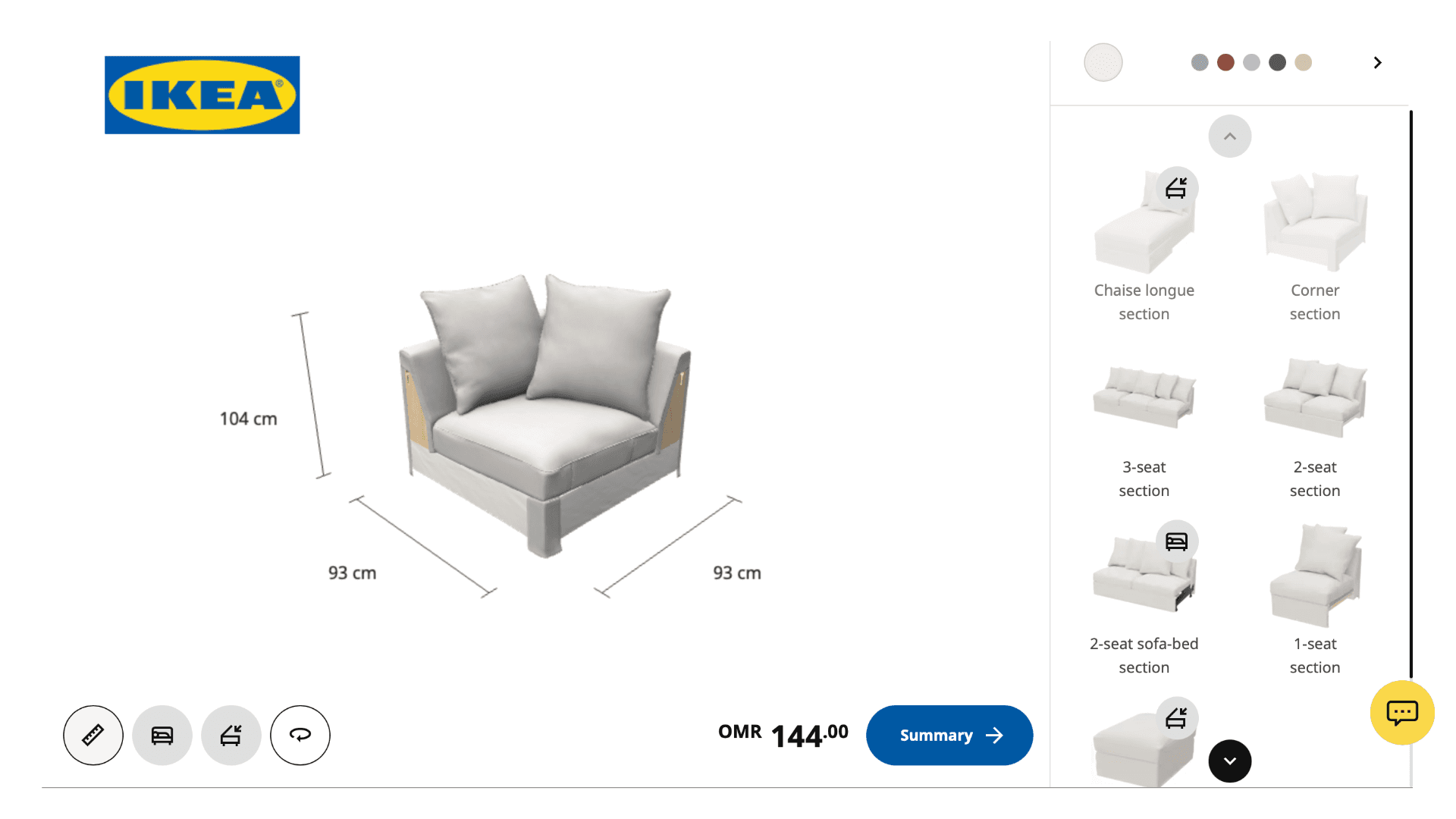
IKEA, the global furniture retailer. IKEA has been a pioneer in using 3D rendering and visualization to showcase their furniture in various room settings through their online platform and mobile app. This strategy provided customers with a visual representation of how the furniture would look in various environments. The measurable impact included:
Boosted Sales: Sales increased by 25% within six months of implementing 3D product visualization.
Improved Customer Experience: Customers appreciated the ability to visualize furniture in their own spaces, leading to higher satisfaction rates.
Streamlined Design Process: The manufacturer also benefited from using 3D renderings during the design phase, reducing prototyping costs and accelerating time-to-market.
Automotive Industry Example
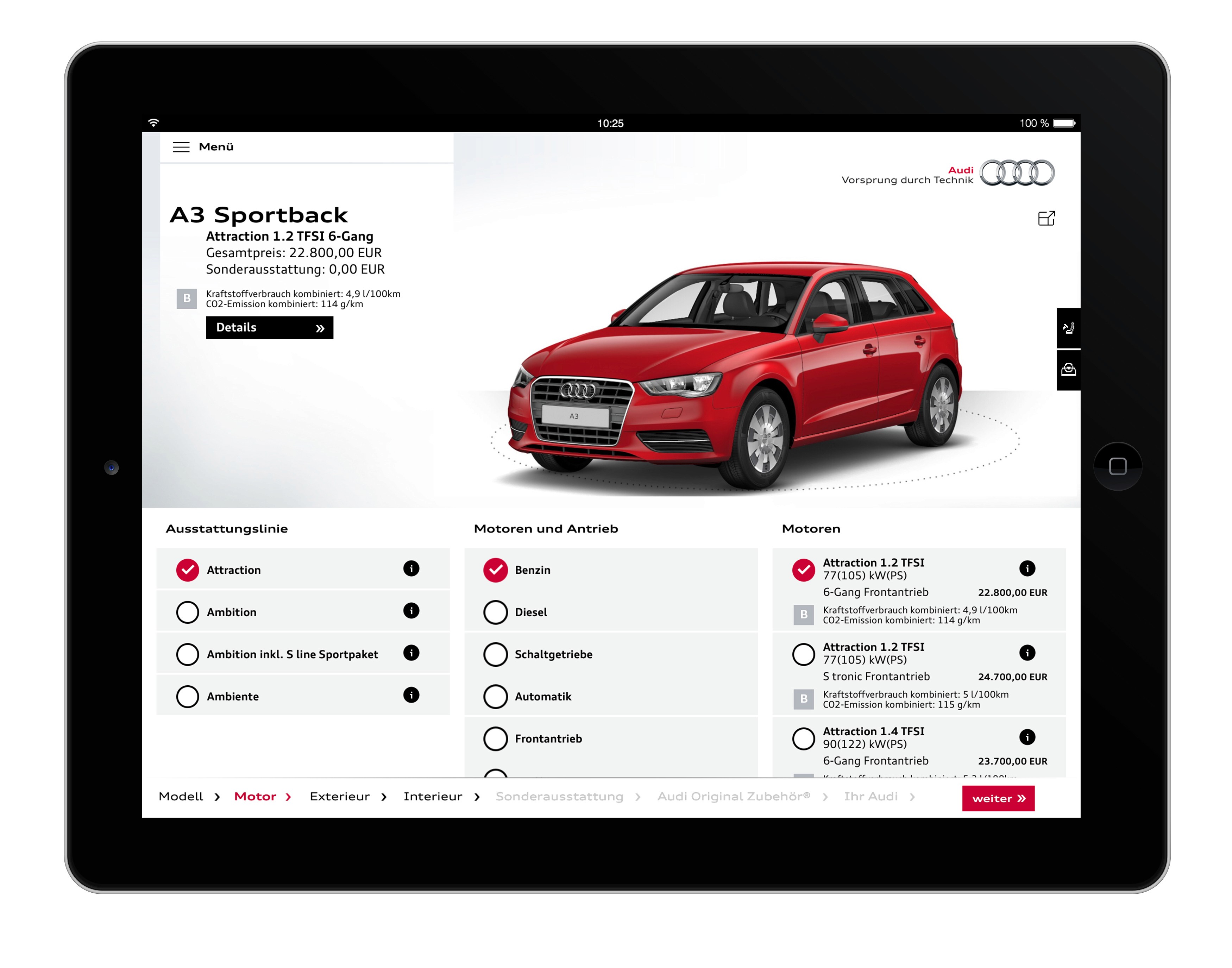
Audi, the luxury automotive manufacturer, leveraged 3D rendering to create hyper-realistic visuals for their marketing campaigns and online configurators. By allowing potential buyers to customize vehicles with different colors, wheels, and interiors, the company achieved significant results:
Higher Engagement: Users spent an average of 50% more time on the website configuring their dream cars.
Increased Lead Generation: There was a 30% rise in lead generation as users were more inclined to request quotes or schedule test drives after interacting with the configurator.
Enhanced Brand Perception: The high-quality visuals elevated the brand’s image, positioning it as innovative and customer-centric.
Industry-Wide Impact
The integration of 3D product rendering has proven beneficial across various industries beyond e-commerce, furniture, and automotive sectors. Key impacts include:
Measurable Improvement in Sales: Brands that adopt 3D visualization often report sales increases ranging from 10% to over 35%, depending on the industry and implementation scale.
Enhanced Customer Engagement: Interactive and immersive experiences foster deeper connections between customers and products.
Strengthened Brand Loyalty: High-quality visual content boosts brand perception, leading to increased customer loyalty and repeat business.
Highlighting Specific Industries:
E-commerce:Measurable ROI: Higher conversion rates, lower return rates.
Case Study Impact: Detailed product views lead to more informed purchasing decisions.
Furniture:Visual Appeal: Customers can see products in various settings.
ROI Metrics: Increased sales, improved design efficiency.
Conclusion
Investing in 3D product rendering offers long-term benefits that significantly enhance marketing outcomes. By providing hyper-realistic visuals, businesses can achieve higher customer engagement and more informed purchasing decisions. This leads to increased sales and reduced return rates, creating a solid return on investment (ROI).
Key points covered include:
Enhanced Customer Engagement: Immersive 3D renderings captivate potential buyers, offering a more detailed and accurate representation of products.
Cost-Effectiveness: Compared to traditional photography, 3D rendering is scalable and often more affordable, particularly for complex items or large-scale campaigns.
Competitive Advantage: High-quality product visuals set businesses apart in a crowded market, ensuring better brand recognition and trust.
Jobe Graphic stands out by delivering exceptional quality through dedicated artist teams tailored to your specific needs, whether you're a marketing company, product developer, or hardware business. Our unique subscription model ensures predictable costs, saving both time and money while providing flexibility and reliability. To understand more about our terms and conditions related to the 3D rendering subscription services, feel free to review them.
By choosing Jobe Graphic’s affordable product rendering services, you not only invest in top-notch visuals but also optimize your marketing strategy to maximize profits effectively. Explore our offerings today to elevate your brand’s visual appeal and drive superior marketing results. Rest assured, we prioritize your privacy while providing these services as outlined in our privacy policy. For any inquiries or further information about our professional 3D rendering services, visit our about page.
What is 3D product rendering and how does it differ from traditional photography?
3D product rendering is the process of creating photorealistic images of products using 3D modeling software. Unlike traditional photography, which captures real-life images, 3D rendering allows for greater flexibility in design, enabling the creation of visuals that can be manipulated for various marketing needs without the constraints of physical photography.
What are the key benefits of investing in 3D product rendering?
Investing in 3D product rendering offers several benefits, including improved customer engagement through immersive experiences, a competitive advantage with high-quality visuals, reduced errors in product representation leading to lower return rates, and enhanced product accuracy that saves businesses time and resources.
How can startups afford high-quality 3D rendering services?
Startups can access affordable 3D rendering services through cost-effective solutions like subscription models that provide predictable pricing. By comparing different pricing tiers and services available for startups, they can find options that balance cost with quality to ensure a good return on investment.
What factors should I consider when choosing a product rendering service provider?
When selecting a rendering service provider, consider factors such as the quality of their previous work, cost-effectiveness, turnaround time, and flexibility in services offered. Evaluating portfolios and client reviews can help ensure you choose a provider that meets your specific needs.
How do I calculate the ROI of using 3D product rendering in my marketing strategy?
To calculate ROI from implementing 3D rendering, businesses should track key metrics such as increased sales, reduced return rates, and enhanced customer satisfaction. Simple formulas or tools can be used to estimate ROI based on these metrics to assess the long-term value and scalability of their investment.
by
Ayham Ayoub
Last updated


